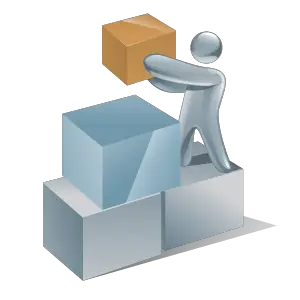Before one can understand backward integration, one must first understand vertical integration because backward integration is essentially a type of vertical integration.
But just understanding Vertical Integration without learning about its counterpart strategy — Horizontal Integration — would be like solving a puzzle with a missing piece. So, to help you develop a holistic understanding, I will first run you through Vertical & Horizontal integration briefly before explaining Backward Integration.
Companies looking to expand their business generally employ either of the two strategies: Horizontal Integration or Vertical Integration.
Horizontal integration is when a company expands by acquiring a similar one in their industry at the same level of the supply chain. An example of Horizontal integration would be a large hotel chain buying another chain of hotels, either similar in size to the acquirer or smaller than it.
Vertical integration is when a company expands by acquiring another company that operates before or after them in the supply chain. For example, a clothing manufacturer acquiring its raw material supplier or a retail chain that sells its products would be an example of Vertical Integration.
As I mentioned at the beginning of the article, Backward Integration is a type of Vertical Integration. If a vertically integrating company acquires a company behind it in the supply chain, it is called Backward Integration. In the example stated earlier, the clothing manufacturer acquiring its raw material supplier is an example of Backward integration since the manufacturer is buying out an operator before it in the supply chain. If the manufacturer were to pay the retail chain ahead of it to control distribution, it would be an example of forward integration.
To develop a better understanding of how Backward Integration exactly works, let’s check out three different examples of the same.
Real-world examples of Backward Vertical Integration
Carnegie Steel Backward Integration
Carnegie Steel is one of the first famous examples of backward integration implementation. Being a steel company, Carnegie Steel needed ‘coke’ to produce steel. Suppliers made coke in ‘blast furnaces’ close to the factory, but they were unable to meet the demand from Carnegie. To remove dependency from suppliers and ensure a constant supply, Carnegie constructed its own blast furnaces for producing coke.
Netflix Backward Integration
Netflix originally started renting DVDs through the mail but later pivoted to providing on-demand entertainment using the internet. As a streaming service, the company would entirely rely on licensed shows to fill up its content library in its early days. Later, Netflix employed the backward integration strategy, starting their own production house to make Netflix original shows.
Amazon Backward Integration
Amazon started as an online book retailer in 1994, procuring books from publishers. In 2009, Amazon integrated backward by launching “Amazon Publishing” to publish books on their own.
Backward Integration Advantages
Increased Supply Chain Control
Like we saw in Carnegie Steel’s case, Backward Integration gives companies increased control over the supply chain, reducing dependency on third-party suppliers. The reduction in dependency gives companies increased control over the quality of raw materials used in production and tighter control over the quantity and delivery of the raw materials.
Cost Efficiency
A textbook example of a supply chain includes the following components: raw material maker, supplier, manufacturer, distributor, retailer & consumer. The more middlemen in a supply chain, the more the final cost of goods for consumers because every intermediary adds a markup to earn profit.
By acquiring a company operating a level before it in the supply chain, companies remove the middlemen involved and cut the markup costs. Companies can then pass on a portion of the markup savings to the customers, reducing the final costs of goods for consumers, as well as increasing their profit by retaining a part of the middlemen markup for themselves.
Competitive Advantage
One of the many reasons companies integrate backward is to gain the upper hand over competitors. Imagine a hypothetical scenario where a single supplier is responsible for supplying materials to two companies, but one purchases the supplier and stops providing goods to the competitor. In this case, the competitor would either have to arrange supplies itself or exit the market. Consolidating the supplier stage of the supply chain by integrating backward would also increase the barriers to entry for new competitors.
Backward Integration Disadvantages
Unintended Inefficiencies
One of the significant drawbacks of backward integration is that it can lead to unintended inefficiencies with the company and also the overall market as a result of it. In some cases, after acquiring the supplier of raw materials in the production process, the company could limit competition, turning lethargic and preventing innovation. Since the company would effectively control the raw material supply, it would be less incentivized to spend on research and development.
Huge Investments
To integrate backward in the supply chain, companies require huge upfront investment to finance acquisitions or build their setup. Companies have to deplete cash reserves and even take debt in some cases. While the backward integration can still benefit companies in the long term, things can also go south if the implementation fails.
Synergy Failure
Acquisitions going south due to a culture mismatch is a common phenomenon. If a company acquires another company with an extremely different culture and mindset, a synergy failure can happen between the two entities. Even if the intent behind the acquisition was to create one unified company, culture mismatch can act as a big deterrent in the process.
Learn More Business Concepts
![Backward Integration [Definition, Examples, ADV & Disad ]](https://whatisthebusinessmodelof.com/wp-content/uploads/2021/11/BackwardIntegrationExamples.png)
